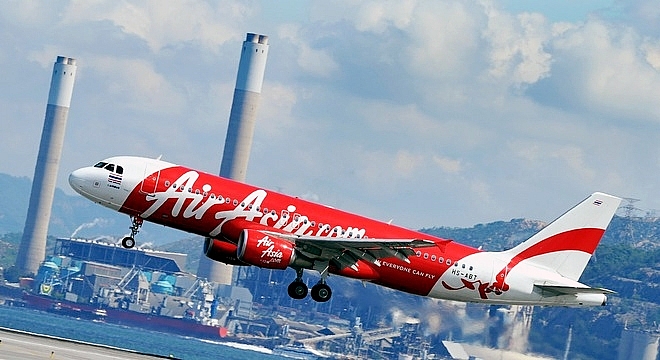Air Asia refuses to give up on Vietnam
 |
| Air Asia remains determined to penetrate deeper into the Vietnamese aviation market |
Vietnam – a market that cannot be ignore market
Tran Trong Kien, the owner of Thien Minh Group (TMG), joined hands with Malaysia's low-cost carrier AirAsia Berhad to develop in Vietnam.
In 2017, Air Asia revealed investing nearly $43.8 million in establishing a joint venture with Hai Au Aviation (HAA) to set up a low-cost airline in Vietnam. Specifically, AirAsia Investment Limited (AAIL), wholly-owned by Tony Fernandes, holds a 30 per cent stake, Gumin Co Ltd holds 69.9 per cent, and Tran Trong Kien's HAA, which operates a general aviation business in Vietnam, will form the vehicle for the joint venture.
AAIL and the joint venture company also signed a loan agreement. Under the deal, AAIL will provide a loan of $2 million and Gumin will provide a loan of $4 million.
Vietnam is the newest market of Air Asia. Previously, Air Asia invested in India, Indonesia, Japan, and Thailand.
Attending Vietnam Economic Forum (ViEF) 2018 Travel & Tourism Summit in Hanoi on December 6, 2018, Air Asia’s CEO shared that in Vietnam the firm grew by 43 per cent in 13 years and transport 10 million passengers.
Eight years ago, Tony Fernandes, CEO of AirAsia signed a strategic agreement with Vietjet Air, but the deal fell through. But it is seems that “giving up” is not a word in this CEO’s dictionary. While the population of the whole of Southeast Asia is about 700 million people, the Vietnamese market’s nearly one hundred million potential customers are hard to ignore.
Vietnam is the fifth largest aviation market in the region and has a passenger growth rate of 28 per cent.
Vietnam is predicted to rank fifth in the world in passenger growth in 2015-2035 with the compound annual growth rate (CAGR) reaching 6.7 per cent per year, higher than the average of the Asia-Pacific region (4.6 per cent).
“Creating an airline is not so difficult, but creating an airline which can be sustainably developed is really a challenge,” Kien said.
Needing a good foundation
“15 years ago, at the beginning of Air Asia, we only had two aircrafts, while Malaysia Airlines had 250. Most of the 700 million people in Southeast Asia, including one hundred million Vietnamese people, have not been on a plane yet or only used domestic flights,” said Tony, expressing his firm belief that competitiveness comes from creating new markets. Therefore, he would like to create routes like Bangkok-Danang or Chiangmai-Danang, which have not been exploited yet.
AirAsia will offer cheaper prices than Vietnamese brands like Vietnam Airlines, Vietjet, Jetstar, and FLC Group’s upcoming Bamboo Airways, while also having more customers around the world.
According to Tony, the Vietnamese aviation market currently focuses on business class, special economy class, and long-haul flights, while the tourism market will be driven by short flights and low-cost destinations.
In addition, Tony expects that Vietnam will allow private businesses to enter the race to develop airport infrastructure, following the example of Thailand, Malaysia, and the Philippines. Besides, the company will focus on digitalisation.
Latecomer advantage
In the Malaysian aviation market, AirAsia is the latecomer. Malaysia Airlines (MAS) is one of the oldest state-owned airlines, but now it is facing fierce competition from low-cost airlines like AirAsia.
Established in 1993 and officially operating since 1996, AirAsia has passed MAS to become the aviation firm that has the largest scale and number of routes in Malaysia.
Currently, Southeast Asia has about 23 low-cost airlines, and two out of three of the seats belong to AirAsia. AirAsia has been honoured as the world's best international low-cost airline for eight consecutive years until 2016.
Tony Fernandes used to be vice-president of Time Warner Music with $226,000 to buy AirAsia.
Tony is confident of success in Vietnam as many traditional airlines in Asia have been driven to the verge of collapse by low-cost carriers thanks to their cost-effectiveness and dynamism.
What the stars mean:
★ Poor ★ ★ Promising ★★★ Good ★★★★ Very good ★★★★★ Exceptional
Related Contents
Latest News
More News
- The destinations powering Vietnam’s festive season travel demand (December 04, 2025 | 18:33)
- Vietnam named among the world’s most exciting winter destinations (December 04, 2025 | 15:10)
- Phu Tho emerges as northern Vietnam’s new tourism hub (December 01, 2025 | 17:00)
- Vietjet completes Airbus A320/A321 updates ahead of deadline (December 01, 2025 | 09:49)
- Vietjet resumes Con Dao flights from early December (November 28, 2025 | 15:24)
- Free tickets, Lunar New Year promotions on offer at Vietjet Mega Livestream (November 26, 2025 | 15:32)
- Scandinavian Airlines and Vietnam Airlines broaden agreement with new routes (November 25, 2025 | 17:04)
- Halong Cruise Port welcomes over 3,100 international visitors (November 12, 2025 | 18:06)
- Vietnam.travel climbs to second place in Southeast Asia website rankings (November 12, 2025 | 18:01)
- Cat Ba named among Southeast Asia’s top island adventures (November 11, 2025 | 18:09)

 Tag:
Tag:























 Mobile Version
Mobile Version